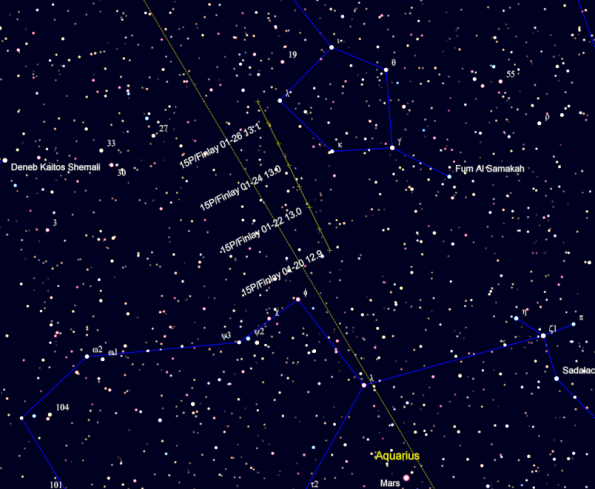01/20/2015 – Ephemeris – Keeping track of Comet 2014 Q2 (Lovejoy) and also 15P/Finley unexpectedly brightens
Ephemeris for Tuesday, January 20th. The sun will rise at 8:13. It’ll be up for 9 hours and 21 minutes, setting at 5:34. The moon is new today, and won’t be visible.
Comet 2014 Q2 (Lovejoy) the to use its official name, is now moving through the constellation of Aries the ram, just west or to the right of the Pleiades. Comet Lovejoy is actually visible to the naked eye from a dark location, far from city lights. It appears to be about 4 ½ magnitude, about a bright as the dimmest star in the bowl of the Little Dipper. It’s tail is still only visible in photographs. It appears that Comet Lovejoy is not a very dusty comet. Dust in comets appears to have the size of smoke particles to be affected they way they are by the pressure of sunlight. Larger particles grains are usually invisible and would only become visible then they burn up in the Earth’s atmosphere. No chance with Comet Lovejoy, it will never get closer to the Earth than Mars.
Times are for the Traverse City/Interlochen area of Michigan. They may be different for your location.
Addendum
This is the comet track ending tonight from last Wednesday’s post.

The track of Comet Lovejoy for the week (from 1/14/2015 to 1/20/2015 at 9 p.m.) Created using Cartes du Ceil (Sky Charts).
This is tomorrow’s track for the next week

The track of Comet Lovejoy for the next week (from 1/21/2015 to 1/27/2015 at 9 p.m.) Created using Cartes du Ceil (Sky Charts).

Brightness curve for C/2014 Q2 (Lovejoy). Vertical axis is magnitude, Horizontal axis is date. The orange line is projected magnitude and black dots are actual reported observational estimates of magnitudes. The vertical line in the center is for the date the comet is closest to the sun, perihelion. As of January 18, 2015 Credit: Seiichi Yoshida.
This is a great website for keeping track of observable comets: http://www.aerith.net/comet/weekly/current.html.
Comet 15P/Finley is a very dim comet, usually relegated to large amateur telescopes. However twice on this trip to the inner solar system it has brightened remarkably from being barely visible at magnitude 10 in 3-4 inch telescopes, to 7th magnitude, visible in binoculars. A 3 magnitude jump in brightness means it brightened by some 16 times. Something’s going on!

Finder chart for Comet Finley with stars down to 9th magnitude. The 5 sided circle of stars above and right of the track is the “Circlet” of the constellation Pisces. Created using Cartes du Ceil (Sky Charts).

General view of the planets and constellations looking to the southwest at 7 p.m. The comet is not visible in this view. Note that Mars is unmarked under the Aq in Aquarius. Created using Cartes du Ceil (Sky Charts).

Brightness curve for 15P/Finley. Vertical axis is magnitude, Horizontal axis is date. The orange line is the projected magnitude and black dots are actual reported observational estimates of magnitudes. As of January 18, 2015 Credit: Seiichi Yoshida.
Tip o’ the old observers cap to Universe Today for the heads up.